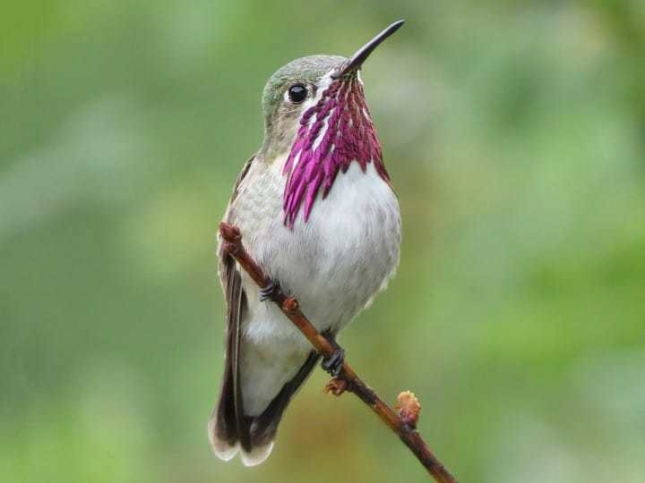FUN FACTS ABOUT CALLIOPE HUMMINGBIRDS

The Calliope Hummingbird is named after the muse, Calliope, who may have inspired Homer to write the “Iliad and the Odyssey”. They are also the smallest migratory bird in the world.
APPEARANCE:
Calliope Hummingbirds are about one third of the size of the North American Warblers and are the smallest bird in the United States
The upper portion of their back and head is green in color
The male Calliope Hummingbird stands out from other Hummingbirds because of their magenta throat
Females have a dull whitish throat and a light cinnamon-beige chest
Immature Calliopes resemble mature females, but have ridges along the upper mandible
SONG:
The call of the Calliope Hummingbird sounds like the bickering and twittering sounds of other Hummingbirds
HABITAT:
The Calliope Hummingbird spends winters in Mexico and parts of the southern United States
Although they may breed at lower elevations, down to 600 feet, they live primarily between 4,000-11,000 feet
This small bird likes cool environments in open Montane forests, mountain meadows, and willow and alder thickets
When it is winter, or they are migrating they can be found in chaparral, lowland brushy areas, desers and semi-desert areas
Their migratory route in the spring is generally up the Pacific coast and then down the interior Rocky Mountain region in the fall
FOOD:
Calliope Hummingbirds enjoy nectar and insects
The types of flowers that they like to get nectar from are cup-shaped flowers and tubular flowers that are smaller, that larger Hummingbirds do not usually seek out
They will perch on a branch and fly out to catch an insect in mid-air
Sapwells, which are created by sapsuckers, are also a prime feeding location for Calliope Hummingbirds, as they can collect both sap and insects at the same time
NESTING:
Courting males will hover in front of and slightly above prospective female mates
Females may respond by playing “hard-to-get” and take flight
Mating males and females may fly in circles around each other, sometimes joining bills
Male Calliopes will protect and defend their feeding and breeding territory, although they may defer to large Hummingbirds
The males will chase off larger birds
Males are not monogamous and will breed with more than one female per season
The male Calliope Hummingbird does not assist with any of the nesting responsibilities
Nests are built and tended by females and are mainly in coniferous trees in protected overhanging branches
The nest is a circular cup that may be built using an old pinecone as the base. The inside is lined with soft plant material, while the exterior consists of lichens, moss and/or bark pieces held together by pieces of spider webs
Outside dimensions of the nest are approximately 1.5-1.8 inches wide and a little over one inch high
The nest of the Calliope may be used over again; however, they will rebuild on top of the first, so the sides are higher
Inside dimensions of the nest are 0.8 in diameter and 0.6 inches deep
Clutch size: two eggs
Number of broods: 1-2
Egg size: 4-0.5 inches length. Width is 0.3-0.4 inches
Incubation: 15-16 days
Nesting Period : 18-21 days
Egg: Smooth white
Appearance of chicks at hatch: Naked
ATTRACTING CALLIOPE HUMMINGBIRDS TO YOUR YARD:
The easiest way to attract Hummingbirds to your yard is by hanging a hummingbird feeder and filling it with a sugar water solution at a ratio of ¼ cup of sugar to 1 cup of water
Place your Hummingbird feeder in the shade so that the nectar will keep better
Hummingbird feeders are typically red, as Hummingbirds know that there is generally more nectar in red flowers and fewer insects
OTHER COOL FACTS:
Metabolic rates increase more than 16 times the resting rate when Calliope Hummingbirds are hovering
The oldest recorded Calliope Hummingbird is a banded female that was, at least, eight years and one month old when she was recaptured in 2014
Males migrate about a month before the females
The males head south while the females are still caring for the chicks
Females head south before the juveniles, leaving the juveniles to travel alone without any adult, parential supervision

